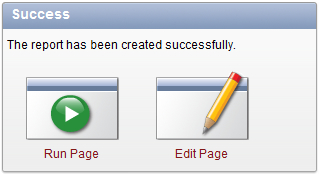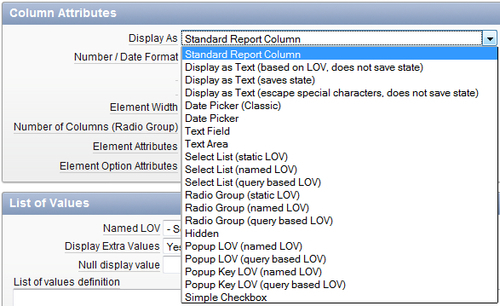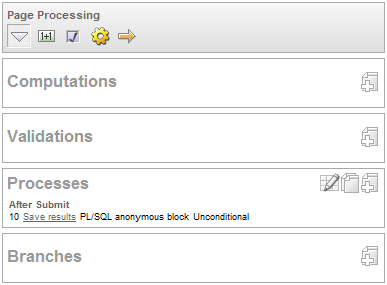APEX_ITEM is a PL/SQL package that you can use to programmatically put items on the screen. The package also contains a function to put hidden items on the screen. Hidden items are items that are placed in a webpage but are not visible. However, they can contain a value. In this way, you can make each row in a report unique. We will make an updatable report which makes use of the APEX_ITEM API.
First, we will make a classic report based on the APP_EVENTS table.
- In the application builder, click the Create page button.
- Select Report.
- Select Classic report.
- Enter a name for the page and click Next.
- Select Do not use tabs and click Next.
- In the text area, enter the following query:
select apex_item.hidden(1,id)||apex_item.text(2,event) appevent , apex_item.date_popup(3,rownum,event_date,'dd-mm-yyyy') event_date , apex_item.text(4,location) location , apex_item.text(5,event_type) event_type from app_events;
[1346_07_01.txt]
- Click Next.
- You can enter a region name. After that, click Next.
- Click Finish. The report has been created and we are now going to edit it.

- Click the Edit Page icon.
- Click on the Report link in the regions section to edit the report attributes.
- Click on the Edit icon (the pencil) to edit the first column.
- In the column attributes section, select Standard Report Column in the Display As listbox.

- Click the Apply changes button.
- Repeat these steps for the other three columns and click the Apply changes button to return to the page definition.
Now we will make a button and a page process to enable the saving of data.
- In the buttons section, click the Add icon.
- Select a region for the button and click Next.
- Select Create a button in a region position and click Next.
- Enter a name for the button, for example Save. Enter a label for the button. You can enter here Save as well. Click Next.
- Select Bottom of region and click Next.
- In the action list box, select Submit Page. Click Create button.
- In the Processes section, click the Add icon.

- Select PL/SQL.
- Enter a name for the page process. You can enter here save_results. Click Next.
- In the text area, enter the following code:
begin for i in 1..apex_application.g_f01.count loop update app_events set event = apex_application.g_f02(i) , event_date = to_date(apex_application.g_f03(i), 'dd-mm-yyyy') , location = apex_application.g_f04(i) , event_type = apex_application.g_f05(i) where id = to_number(apex_application.g_f01(i)); end loop; end;
[1346_07_2.txt]
- Click the Create process button.
- The page is ready. Run it and try to change some values in the page. Then try to save by clicking the Save button.
With APEX_ITEM you can put an item on the screen. The first parameter in the function (hidden, text, or date_popup) is the index which you can use to find the item back. Let's say you use the following command to put an item on the screen:
APEX_ITEM.TEXT(2,'COLUMN_NAME')
When submitted, the values of the APEX items will be stored in the PL/SQL array APEX_APPLICATION.G_F0X. Then you can find this item back with:
APEX_APPLICATION.G_F02(i).
Where i is the row indicator in case you are working with a multi row tabular form.
Furthermore, you can use the first variable to do some aggregate functions like count. Use it in the following way:
APEX_APPLICATION.G_F01.COUNT.
Note that the example in this recipe only handles existing rows.
